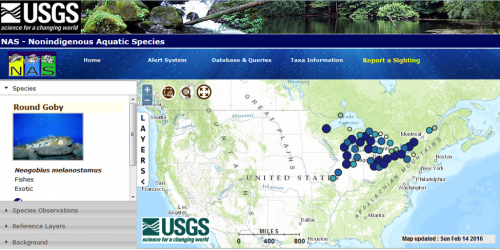National Invasive Species Awareness Week: Round goby
Part 5 in a series to learn about invasive species and what to do to help protect Michigan and the Great Lakes.

National Invasive Species Week 2016 is February 21-27. Invasive species are plants, animals, and other organisms that are not traditionally found in a given location (in this case the Great Lakes) AND are having a negative impact of some kind, whether ecological, economic, social, and/or a public health threat.
To help bring awareness to this week, Michigan State University Extension (MSUE) and Michigan Sea Grant are featuring invasive species that have invaded or have the potential to invade Michigan’s environment. Today’s featured aquatic invasive species is the round goby.
Species Name: Round goby (Neogobius melanostomus)
Description: According to the Midwest Invasive Species Information Network this invasive fish species is tan-gray with small dark blotches on its sides. The body is robust and tapered with a thick caudal peduncle. Round gobies also have a large blunt head with a subterminal mouth and partially protruding eyes and a small dark spot at the base of the upper pectoral rays. They are bottom-dwelling fish that can reach up to 10 inches in length.
Similar species: The round goby is similar to the mottled sculpin (native to Michigan) and the tubenose goby (another non-native species).
Origin: The round goby is native to the Black, Caspian, and Azov seas (and their tributaries) in Eastern Europe and the Middle East.
How it came to the Great Lakes: Round gobies came to the Great Lakes in the ballast water of ocean going freighters.
How long it has been here: Round gobies were first discovered in the 1990s in the Michigan waters of the St. Clair River (a Great Lakes tributary).
Extent of range: Round gobies are found throughout the Great Lakes and into southern Illinois near Jacksonville and southern New York near Binghampton.
Why it is a problem: Round gobies are voracious eaters and thus competition for food is one of the main negative impacts on native species. However, the native sculpin also suffers from reproductive pressures as round gobies aggressively push the male sculpins off of the nests that they are attempting to guard from predators.
How it is spread: Round gobies spread to un-infested areas through commercial and recreational boating and discarded bait fish.
A cool/unusual fact: Although invasive, round gobies are now a staple food item of native bass species.
Management actions/options: Once an invasive species becomes as widespread and abundant as the round goby has become in the Great Lakes, no possibility of complete eradication exists. The goby has become a permanent fixture in the Great Lakes food web. However, some researchers are experimenting with localized controls using fish poisons and seismic guns.
What you can do to help prevent the spread: You can prevent the spread of yellow floating hearts by 1) help educate others about identifying and preventing the spread of round gobies and 2) practicing the Clean, Drain and Dry method for watercraft prior to moving them between lakes. Watch the video.
Michigan Sea Grant helps to foster economic growth and protect Michigan’s coastal, Great Lakes resources through education, research and outreach. A collaborative effort of the University of Michigan and Michigan State University and its MSU Extension, Michigan Sea Grant is part of the NOAA-National Sea Grant network of 33 university-based programs.
Read the aquatic series:
Read the terrestrial series:
Invasive Species Resources:
Michigan Invasive Species UofM-Dearborn Incident Summary
Midwest Invasive Species Information Network round goby fact sheet
http://www.misin.msu.edu/tools/apps/
http://mnfi.anr.msu.edu/invasive-species/invasives.cfm#publications
http://mnfi.anr.msu.edu/invasive-species/fieldguide.cfm
http://www.glerl.noaa.gov/res/Programs/glansis/
http://www.michigan.gov/dnr/0,4570,7-153-10370_59996---,00.html



 Print
Print Email
Email




